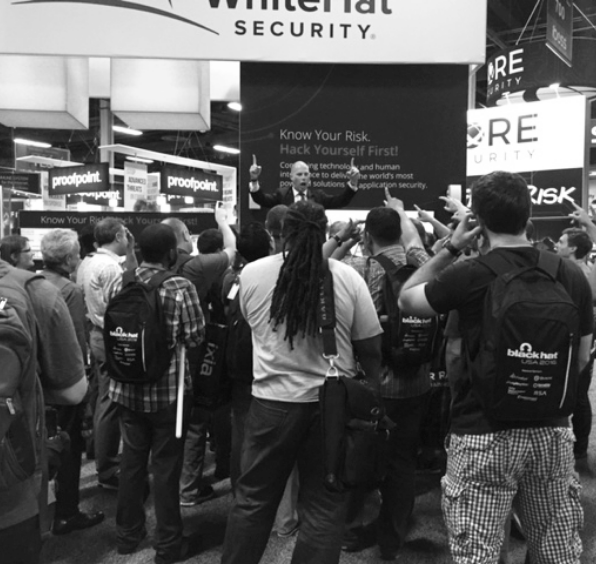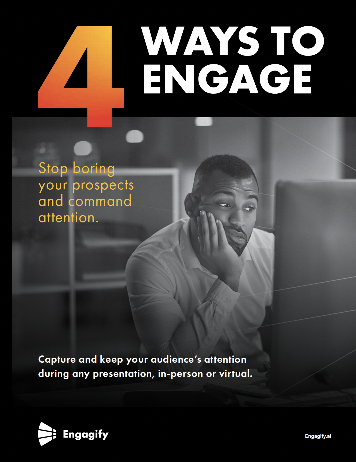Sales engagement can take many forms, and it’s a good idea to check yourself from time to time, to make sure you’re doing it right.
One of the most challenging situations you could ever be in is having to engage at a trade show. On the surface it appears simple, right? All you need is to get a colorful booth together and people it with a few gregarious staff members. Even better, the bigger your company, the better the brand, the more attractive you automatically are in a trade show. You’re thinking, we’ll just show up, and haul up a nice big shiny logo and viola! It’ll practically do the work for you, so why worry? What could possibly go wrong?
Oh, let me count the ways!
Let me tell you all about 6 engagement mistakes that even the big companies make at trade shows.
1. Chairs in Presentation Theaters
Providing seating for your booth visitors may seem like a good idea, but there are times when this really doesn’t serve you. I’ll give you three great examples:
- First, chairs can take up valuable booth space. Let’s say you have room for 8 chairs in your space. Well, in that same square footage you can have as many as 15 people standing.
- Second, chairs tend to attract low-energy individuals who are only interested in resting their aching feet. So, if the point of your presentation is to educate and filter prospective clients, you won’t get very far with these people. A tired body tends to have a tired mind on top of it! You want to attract people who want to be at your booth during your presentation, not just those who are taking a load off.
- Third, and this is a really cringe-worthy one…empty chairs signify failure. Typically the bigger a booth, the emptier it can look. If you fill the space with chairs, it looks even worse.
I remember working at the National Auto Dealers Association show in Orlando. I walked into this 30-foot by 50-foot booth that was basically made of steel trusses and it had a small stage surrounded by 40 folding director’s chairs. The “booth host” was talking on the microphone, making his presentation, to absolutely no one!
It was such a sad sight because it looked so desperate. Nobody wants to be in an audience where there is nothing of perceived value on offer. Bottom line—empty chairs always look like a failure. Oh, and on a side note, or call it example 3B, empty chairs can also tempt your staff to take it easy.
It’s just poor booth etiquette to be sitting while you are on booth duty. It gives the impression your staff can’t be bothered to stand and talk to the booth visitors on their level. At the same time, attendees will look for the tiniest excuse not to talk to your staff; they may feel that they “don’t want to disturb them.”
Yes, I get the fact your staff’s feet will ache. And, when they see an empty chair nearby, they’re “only gonna sit in it just for a second.” But, sure enough, the next thing you know you have your entire staff sitting and talking amongst themselves.
This is not the image you want to portray to your potential clients. Engaging? Not!
2. High Concept/ Low Response
In addition to those who think a trade show will virtually do the sales engagement job for them, there are those individuals who become very excited and even inspired at the idea of a trade show as it provides an ideal opportunity to engage by showing off their—let’s say ‘bold’—creativity. And sure, that excitement is commendable and it’s definitely good for team building. But over the last few years I have seen some very creative booth activities that may have seemed like a great idea on the page, but just fell flat once it materialized on the trade show floor.
One of the first sayings I learned in marketing was, “It’s more important to be clear than clever.” The companies I’m about to describe simply forgot the K.I.S.S. principle—Keep It Simple Stupid!
Are you ready? Here they come…
- Full Bodysuit Robot Dancers|
Yes. You read that right. Now, I don’t know how this idea even got out of the boardroom. A couple times an hour, four people would don full bodysuits (like those you see in green screen filming) and dance like robots to loud music. While it was a tech show, there was absolutely no tie-in to the company nor the product.
While it was obviously a spectacle and people did pause and look for a second, wondering what in the world was going on, they wanted no part of it and you guessed it—they skipped the booth. It didn’t engage them, it didn’t even make them want to come closer to the booth.
Isn’t that defeating the purpose?
- Gradually Completed Art
I’ve seen this a number of times, and every time I see it I can’t help but think that the person who signed off on this idea must be a real art enthusiast.
The concept is fairly simple. Over the course of the trade show, visitors contribute to the creation of a piece of art, like colour in a section of a chalk artwork drawn on the floor. It’s a neat idea, but the problem is that only the people who visit at the end of the day, on the last day of the show, can actually see and appreciate the end product.
The majority of visitors to the show see nothing but a work in progress.
I think the mindset here is they want to keep us in suspense, making us say, “What is it?” When in fact, we’re saying: “Who cares? Why bother?”
I’m not trying to be mean or sarcastic. I’m not even saying that you can’t use the element of suspense in a show, I’m merely saying, pulling this kind of irrelevant stunt, often with no connection whatsoever to what’s being offered in the booth, is the very opposite of engagement. It’s annoying rather than compelling. At times it may even come off as self-indulgent. And what, you might ask, has self-indulgence got to do with engagement? Nothing. Besides, it’s only one step up from watching paint dry.
- Skateboard Half Pipe
I saw this at a tech show a few years back. The entire 20-foot by 20-foot booth consisted of a skateboard half pipe and a couple of banner stands. A few times a day, hired skateboarders would take to the half pipe and perform some tricks, adding in a few shout outs to “Drop into XYZ Company.” OK. Got it.
Well, some people watched, for the sheer novelty, but it didn’t hold a crowd for very long. In fact some people didn’t want to get too close, especially after a skateboard flew out of the booth.
Nice, eh? “Come visit our booth, but oh yeah, beware of flying skateboards!”
Are you kidding me?
From an R.O.I. standpoint, I know that this was a disaster—especially after hearing that the company hired Tony Hawk’s company to build the half pipe to the tune of $20,000!
This is why keeping to tried and true lead generation activities is a recommended strategy to integrate into any trade show. It’s okay to keep things fresh, put a new spin on a proven concept, but always stay focused on the goal.
3. Neglecting the Sound
Now hear this: if you use professional presenters or entertainment, you can’t afford to have bad sound. If booth visitors can’t hear you, or the sound is so distorted that it’s annoying, they can and will just move on.
Not only that, poor quality sound can also result in complaints from your booth neighbors. From my experience I find that organizers think of the sound system as an afterthought. It shouldn’t be. Clear audio is one of the main ways to communicate with the world. Don’t neglect this mission-critical detail. Provide a quality sound system that will allow you to communicate your company’s message in a clear and effective way. It’s not an area where you want to cheap out. Consult a professional and communicate your needs. A professional should be able to provide you with some suitable options that fit a variety of budgets.
4. Psychological Barriers
Trade show attendees are a fickle bunch. They are easily led and blocked by tables, chairs, brochure racks. Some barriers though are entirely subconscious. Did you know that the line where the aisle meets the booth can be a psychological barrier? When you see the color change, an unconscious signal is sent out and people tend to line up right along the border of the booth. Why does this happen?
Maybe people either don’t know they’re doing it, or, maybe they don’t want to get roped into something. Either way, trade show attendees feel safer and more comfortable in the aisle.
The solution to this odd problem is simple. Choose a rug for your booth that matches the aisle color in your booth. Talk to show management and find out what color the aisles will be. Typically, the aisles will be black or grey, sometimes red. The black and grey are neutral colors and will match almost any booth. The red booth carpet may not work for your company, depending on the colors of your own particular brand. But, once you’ve matched the aisle color, the lines between booth and aisle will blur and people will more naturally flow in. You might even see people cutting across the booth corner. This all happens because people are now completely unaware of the boundaries.
Another side benefit is that your booth staff can now encroach on the aisle. Well—between you and me—trade show management hates when you do this, but, with the matching carpet it’s extremely difficult to tell if you are doing it.
So there you have it: the perimeter of your booth is subtly expanded, and you are now able to maximize your presence at the show.
5. Eye Level is Buy Level
Department stores know this. They strategically place the higher profit items at eye level. This is called merchandising. I’m surprised that this concept is not considered a best practice in the trade show marketing industry. I see it time and time again where presenters, monitors, and signage are not high enough to be seen by more than one person.
But a trade show is all about visibility. Trade shows enable companies to go where the prospects are. So it’s integral that you capitalize on this situation and leverage your message to the best of your ability. Making your products, signage, and people as accessible and easy to spot is integral to maximum exposure.
The stages used for most trade show presenters are typically only 6-10 inches high. I’m only 5-foot-9-inches so even with a 6-inch stage, there are probably still audience members who are taller than I. Put your people on display, and if possible, up high enough for people at the back to see them. We tend to respect things that are ‘above us’ (judges, parents, preachers). Tap into this principle and give your company representative more built-in respect.
6. Not Training Your Booth Staff
Your company’s booth staff has worked a lot of trade shows and they know what they’re doing, right? Or so you think. I’m always amazed at how quickly people either forget, ignore, or are just oblivious to exhibiting best practices that were just reviewed one hour before in the pre-show booth meeting.
I’m a firm believer in the fact that you can’t over train a salesperson. Though a lot of people would agree with me, very few companies actually train their booth staff.
The world of trade shows offers a different kind of business environment. There’s a real shift between your normal work day, and a day spent in your company’s booth. You’re all out in public, for one thing, openly displaying your working selves amongst an ever-changing flow of complete strangers (and, you hope, potential customers). Every second the show floor is open, a dollar figure is attached to it. Your staff must be accountable to the sizable investment that you are making. That person your booth staffer just ignored could have been a million-dollar sale. Do your company a favor and train, and re-train, your booth staff. They are your boots on the ground, and there is no reason why they shouldn’t be on top of their game, doing their very best to engagify.
__________________________
Now that I’ve shared, I hope these are 6 mistakes you’ll never make! Trade shows are a great way to engage, and it’s just good sense to present your best self to the world. Your company will thank you.




